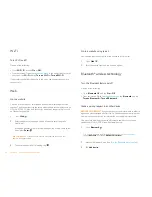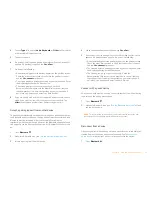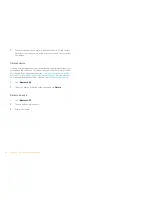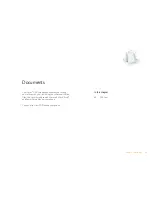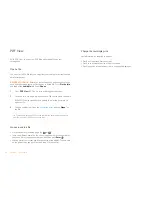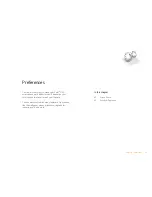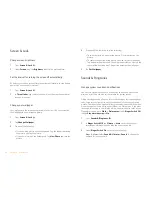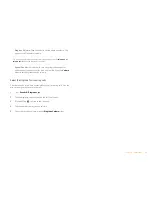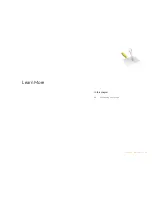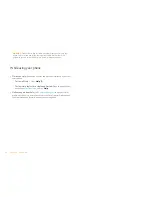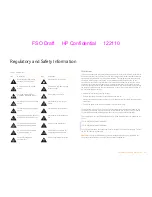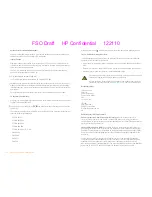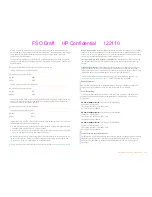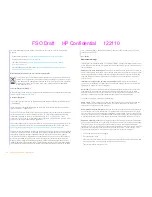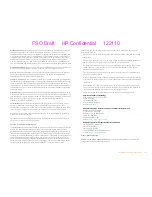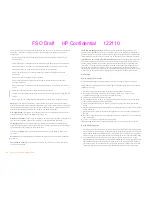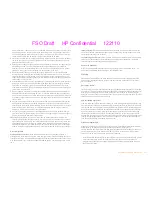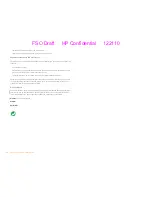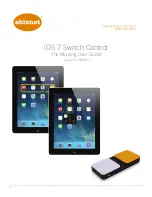
254
Regulatory and Safety Information
For more information about HP’s commitment to the environment, refer to the following
websites:
• Global Citizenship Report:
hp.com/hpinfo/globalcitizenship/gcreport/index.html
• Environmental website:
hp.com/environment
• ISO 14001 Certificate:
hp.com/hpinfo/globalcitizenship/environment/operations/
envmanagement.html
• Material Substitution and Elimination:
hp.com/hpinfo/globalcitizenship/environment/
productdesign/materialuse.html
Disposal of Waste Equipment by Users in Private Households
This symbol means do not dispose of your product with your other household waste.
Instead, you should protect human health and the environment by handing over your
waste equipment to a designated collection point for the recycling of waste electrical
and electronic equipment. For more information, please contact your household
waste disposal service.
Chemical Substances (REACH)
A chemical information report for this product complying with REACH (Regulation EC No 1907/
2006) is available at
hp.com/go/reach
.
Hazardous Substances
This product is in compliance with the Restrictions of Hazardous Substances (RoHS) directive
— 2002/95/EC.
This HP product is designed to comply with the Waste Electrical and Electronic Equipment
(WEEE) Directive — 2002/96/EC.
The EU WEEE directive (2002/95/EC) requires manufacturers to provide treatment information
for each product type for use by treatment facilities. This information (product disassembly
instructions) is posted on the Hewlett-Packard website at
hp.com/go/recyclers
. These
instructions may be used by recyclers and other WEEE treatment facilities as well as HP OEM
customers who integrate and resell HP equipment.
This product does not contain any of the following substances in excess of regulatory limits (for
reference of these limits please refer to the HP General Specification for the Environment at
hp.com/hpinfo/globalcitizenship/environment/suppychain/gen_specifications.html
):
Asbestos, certain azo colorants, certain brominated flame retardants (may not be used as flame
retardants in plastics), cadmium, chlorinated hydrocarbons, chlorinated paraffins, formaldehyde,
halogenated diphenyl methanes, lead carbonates and sulfates, lead and lead compounds,
mercuric oxide batteries, nickel (finishes must not be used on the external surface designed to
be frequently handled or carried by the user), ozone depleting substances, polybrominated
biphenyls (PBBs), polybrominated biphenyl ethers (PBBEs), polybrominated biphenyl oxides
(PBBOs), polychlorinated biphenyl (PCB), polychlorinated terphenyls (PCT), polyvinyl chloride
(PVC) (except for wires and cables, and certain retail packaging has been voluntarily removed
from most applications), radioactive substances, tributyl tin (TBT), triphenyl tin (TPT), and
tributyl tin oxide (TBTO).
User Safety
Operational Warnings
IMPORTANT INFORMATION ON SAFE AND EFFICIENT OPERATION. Read this information
before using your smartphone. For the safe and efficient operation of your smartphone, observe
these guidelines:
Potentially explosive atmospheres:
Turn off your smartphone when you are in any areas with
a potentially explosive atmosphere, such as fueling areas (gas or petrol stations, below deck on
boats), storage facilities for fuel or chemicals, blasting areas and areas near electrical blasting
caps, and areas where there are chemicals or particles (such as metal powders, grains, and
dust) in the air.
Interference to medical and personal Electronic Devices:
Most but not all electronic
equipment is shielded from RF signals and certain electronic equipment may not be shielded
against the RF signals from your smartphone.
Pacemakers:
The Health Industry Manufacturers Association recommends that a minimum
separation of 15 centimeters be maintained between a phone and a pacemaker to avoid
potential interference with the pacemaker. These recommendations are consistent with the
independent research by the recommendations of Wireless Technology Research.
Persons with pacemakers should do the following:
Audio Safety:
This smartphone is capable of producing loud noises which may damage your
hearing. When using the speakerphone feature, it is recommended that you place your
smartphone at a safe distance from your ear.
Other Medical Devices, Hospitals:
If you use any other personal medical device, consult the
manufacturer of your device to determine if it is adequately shielded from external RF energy.
Your physician may be able to assist you in obtaining this information. Turn your phone OFF in
health care facilities when any regulations posted in these areas instruct you to do so. Hospitals
or health care facilities may be using equipment that could be sensitive to external RF energy.
Repetitive Motion Injuries:
When using the keyboard or playing games on your smartphone,
you may experience discomfort in your neck, shoulders, hands, arms, or other parts of the body.
To avoid any injury, such as tendonitis, carpal tunnel syndrome, or other musculoskeletal
disorder, make sure to take necessary breaks from use, take longer rests (such as several hours)
if discomfort or tiring begins, and see a doctor if discomfort persists. To minimize the risk of
Repetitive Motion Injuries, when texting or playing games with your smartphone:
• Do not grip the smartphone too tightly
• Press the buttons lightly
• Make use of the special features in the handset which minimize the number of buttons which
have to be pressed, such as message templates and predictive text
• Take lots of breaks to stretch and relax
FSO Draft HP Confidential 122110

